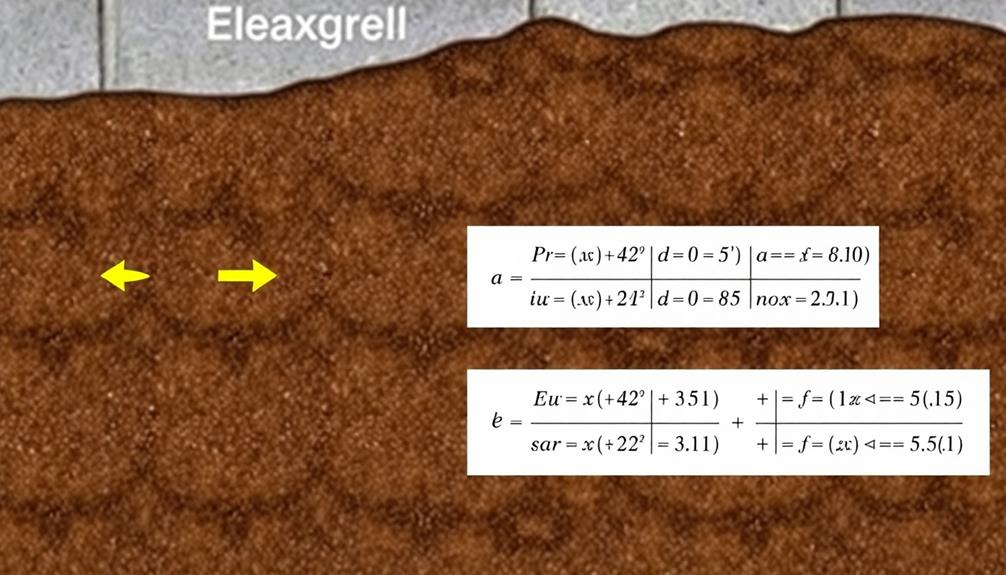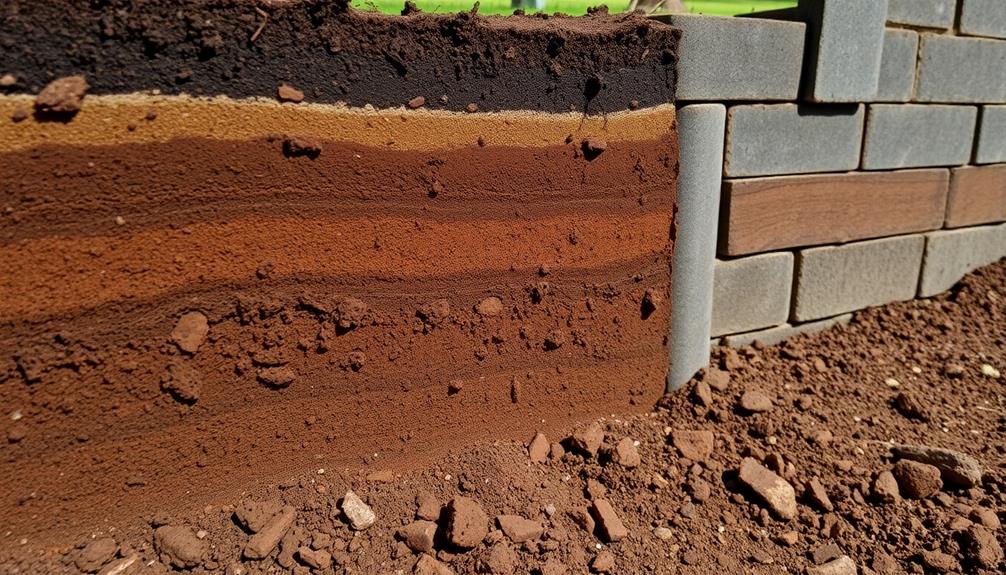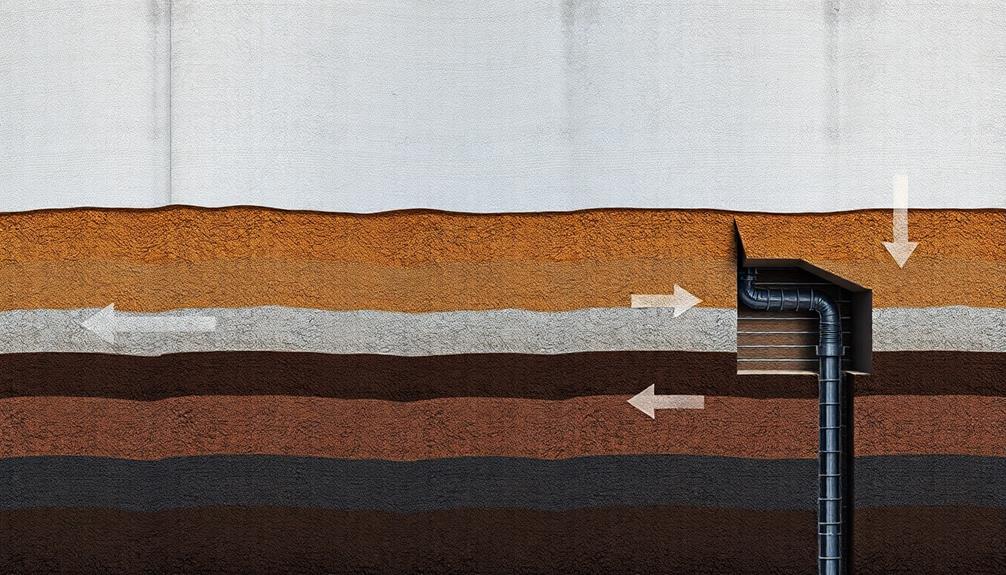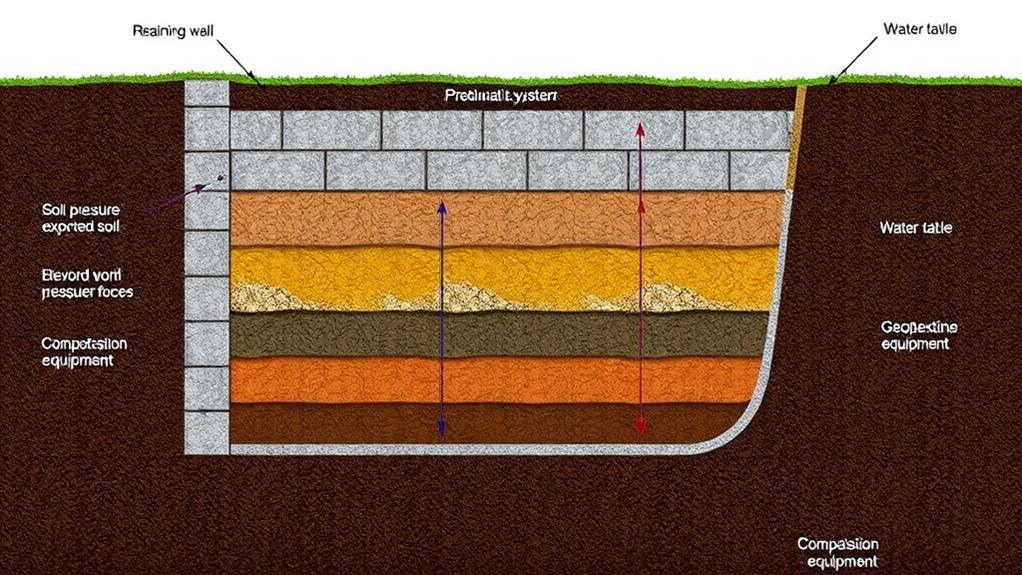When considering soil mechanics for retaining walls, several indispensable factors must be addressed. These include thorough geotechnical investigations to assess soil properties, accurate soil classification using standardized systems, and extensive load distribution analysis. Structural stability and load-bearing capacity are paramount, necessitating careful management of lateral earth pressures and strategic use of reinforcements. Effective drainage management is essential to mitigate hydrostatic pressure and prevent water accumulation. Additionally, soil-wall friction angle analysis, involving direct shear tests and tilt table experiments, plays a pivotal role in determining wall stability. Understanding these intricate aspects of soil mechanics guarantees the design of robust, long-lasting retaining structures that minimize maintenance costs and maximize performance over time.
Table of Contents
ToggleWalls Contractor Highlights
- Soil classification and properties, including shear strength, compressibility, and permeability, to inform retaining wall design.
- Lateral earth pressures and their distribution along the wall height for proper structural stability.
- Drainage considerations to prevent water accumulation and reduce hydrostatic pressure behind the wall.
- Soil-wall friction angle analysis to determine the interaction between the retaining structure and surrounding soil.
- Load-bearing capacity of the foundation soil to ensure adequate support for the retaining wall.
Soil Bearing Capacity Calculation

Accurate soil bearing capacity calculation is vital for designing safe and stable retaining walls, requiring a thorough understanding of geotechnical investigation methods, soil classification systems, and load distribution analysis. Specialized equipment and professional expertise are essential for ensuring proper soil assessment and wall construction, particularly in complex terrain or shoreline environments.
Geotechnical investigations, including in-situ testing and laboratory analysis, provide essential data on soil properties and stratification, while standardized soil classification systems enable consistent categorization of soil types and behaviors. These data inputs inform sophisticated load distribution analyses, which model how forces from the retaining wall structure interact with the underlying soil, ultimately determining the soil's capacity to support the imposed loads without excessive settlement or failure.
Geotechnical Investigation Methods
Determining soil bearing capacity is indispensable for designing safe and stable retaining walls. To accurately assess soil conditions and obtain the necessary data for bearing capacity calculations, geotechnical engineers employ various investigation methods. These techniques provide pivotal information about soil properties, stratification, and potential challenges that may affect the retaining wall's performance.
One of the primary methods used is soil boring, which involves drilling into the ground to collect soil samples at different depths. These samples are then analyzed in laboratories to determine soil classification, moisture content, and shear strength parameters. In-situ testing, such as the Standard Penetration Test (SPT) and Cone Penetration Test (CPT), offers valuable insights into soil density and strength characteristics.
Geophysical methods, including seismic refraction and electrical resistivity surveys, can provide additional data on subsurface conditions without disturbing the soil. For more complex projects, test pits may be excavated to visually inspect soil layers and conduct field tests. By employing a combination of these investigation methods, engineers can develop an all-encompassing understanding of the site's geotechnical properties, enabling them to design retaining walls that effectively withstand lateral earth pressures and guarantee long-term stability.
Soil Classification Systems
Soil classification systems play an essential role in determining soil bearing capacity for retaining wall design. These systems provide a standardized method for categorizing soil types based on their physical and mechanical properties, enabling engineers to make informed decisions about foundation design and load-bearing capabilities. The two most commonly used classification systems in geotechnical engineering are the Unified Soil Classification System (USCS) and the American Association of State Highway and Transportation Officials (AASHTO) system.
The USCS, developed by Arthur Casagrande, classifies soils into 15 groups based on grain size distribution, plasticity, and organic content. This system is particularly useful for retaining wall design as it provides insights into soil behavior under various loading conditions.
The AASHTO system, on the other hand, focuses more on highway subgrade materials and is divided into seven main groups. Both systems utilize laboratory tests such as sieve analysis and Atterberg limits to determine soil properties. By accurately classifying soils, engineers can estimate parameters like shear strength, compressibility, and permeability, which are pivotal for calculating soil bearing capacity and ensuring the stability and longevity of retaining wall structures.
Load Distribution Analysis
Building upon the foundation of soil classification, load distribution analysis is a key component in retaining wall design. This essential process involves calculating the soil bearing capacity, which determines the maximum load the soil can support without excessive settlement or failure. Engineers must consider various factors, including soil type, moisture content, and anticipated loads, to guarantee the retaining wall's stability and longevity.
The analysis typically begins with a thorough site investigation, encompassing soil sampling and in-situ testing. Geotechnical experts then utilize sophisticated modeling techniques to simulate load transfer mechanisms and predict soil behavior under various conditions. These models account for lateral earth pressures, surcharge loads, and potential seismic forces that may affect the retaining wall's performance.
Benefits

Understanding soil mechanics in retaining wall design offers numerous advantages that markedly enhance the structure's performance and longevity. Proper soil analysis and engineering principles are indispensable for preventing erosion and guaranteeing the wall's stability over time.
Increased Structural Stability
Retaining walls' increased structural stability offers considerable benefits in soil retention and site development. By efficiently managing lateral earth pressures and redistributing soil loads, these structures provide a robust solution for challenging terrain conditions. The heightened stability allows for the creation of usable space on sloped landscapes, enabling property owners to maximize land utilization and create aesthetically pleasing environments.
The incorporation of advanced soil mechanics principles in retaining wall design significantly improves their performance under various environmental stresses. Factors such as soil type, moisture content, and drainage patterns are thoroughly analyzed to guarantee sturdy structural integrity. This comprehensive approach results in walls that can withstand substantial lateral forces, resist overturning moments, and maintain their stability over extended periods.
Furthermore, the increased structural stability of retaining walls contributes to the overall safety of construction projects. By effectively controlling soil movement and preventing erosion, these structures mitigate potential hazards associated with unstable slopes. This enhanced safety profile not only protects property and infrastructure but also instills confidence in stakeholders, including property owners, developers, and regulatory bodies, fostering a sense of community assurance in the built environment.
Improved Drainage Management
While structural stability is pivotal, improved drainage management presents equally significant benefits for retaining wall systems. Effective drainage systems mitigate hydrostatic pressure, preventing water accumulation behind the wall that could lead to structural compromise. By implementing proper drainage techniques, engineers can considerably enhance the longevity and performance of retaining walls.
Key benefits of improved drainage management include:
- Reduced soil erosion and settlement
- Minimized frost heave in colder climates
- Increased overall wall stability
- Extended lifespan of the retaining structure
Implementing an extensive drainage system involves strategically placed weep holes, perforated pipes, and properly graded backfill material. These elements work in concert to channel water away from the wall's foundation, maintaining soil integrity and preventing saturation-induced weakening. Additionally, geotextile filters can be incorporated to prevent fine soil particles from clogging drainage pathways, ensuring long-term effectiveness. By addressing drainage concerns proactively, engineers can safeguard retaining walls against potential failures and costly repairs, ultimately providing a more reliable and durable solution for soil retention challenges.
Enhanced Load-Bearing Capacity
The cornerstone of effective retaining wall design lies in its enhanced load-bearing capacity. This pivotal aspect ensures the structure can withstand the immense lateral earth pressures and additional surcharges it may encounter. By optimizing the wall's ability to bear loads, engineers can create more robust and durable structures that stand the test of time and environmental stressors.
To achieve superior load-bearing capacity, several factors must be meticulously considered. These include the careful selection of appropriate backfill materials, implementation of proper compaction techniques, and the strategic use of geosynthetic reinforcements. The integration of these elements results in a cohesive system that effectively distributes loads and minimizes the risk of structural failure.
Additionally, the incorporation of advanced soil stabilization methods, such as soil nailing or mechanically stabilized earth (MSE) systems, can considerably enhance the wall's ability to resist both static and dynamic loads. By employing these sophisticated techniques, engineers can design retaining walls that not only meet but surpass performance expectations, providing property owners and communities with reliable, long-lasting infrastructure solutions that contribute to the overall stability and safety of the built environment.
Reduced Maintenance Costs
Enhanced load-bearing capacity not only improves structural integrity but also contributes substantially to lessened maintenance costs over time. By implementing proper soil mechanics techniques, property owners and engineers can greatly minimize the need for frequent repairs and replacements. This approach leads to long-term financial benefits and increased reliability of retaining wall structures.
To achieve reduced maintenance costs through effective soil mechanics, consider the following key factors:
- Proper drainage systems to prevent water accumulation and soil erosion
- Selection of appropriate backfill materials to maintain structural stability
- Accurate assessment of soil properties and site conditions for ideal design
- Implementation of erosion control measures to protect the wall's foundation
Soil-Wall Friction Angle Analysis

Soil-wall friction angle analysis is a critical component in retaining wall design, influencing the structure's stability and performance. Accurate measurement techniques, such as direct shear tests and tilt table experiments, provide essential data for engineers to assess the interface behavior between soil particles and wall materials. The following table outlines key considerations in soil-wall friction angle analysis, including measurement methods, stability impacts, and material interface factors:
| Aspect | Description | Importance |
|---|---|---|
| Direct Shear Test | Measures shear strength at soil-wall interface | High |
| Tilt Table Experiment | Determines angle of sliding initiation | Medium |
| Roughness of Wall Surface | Affects friction coefficient | High |
| Soil Grain Size | Influences interlocking with wall | Medium |
| Moisture Content | Impacts cohesion and friction | High |
Measurement Techniques
Three primary techniques are employed to measure soil-wall friction angles in retaining wall design: direct shear tests, tilt table tests, and pull-out tests. These methods provide essential data for engineers to accurately assess the interaction between soil and wall surfaces, enabling the development of safe and efficient retaining structures.
To ensure thorough soil-wall friction angle analysis, consider the following key aspects:
- Sample preparation: Carefully collect and prepare soil specimens that accurately represent the site conditions, including moisture content and density.
- Test repetition: Conduct multiple tests to account for variability and obtain statistically significant results.
- Surface characteristics: Evaluate the influence of wall material texture, roughness, and coatings on friction angle measurements.
- Environmental factors: Consider the effects of temperature, humidity, and chemical interactions on soil-wall friction properties.
Impact on Stability
Understanding the impact of soil-wall friction angles on retaining wall stability is crucial for effective design and construction. The soil-wall friction angle, which represents the interaction between the soil and the wall surface, significantly influences the overall performance of the structure. Engineers and designers must carefully analyze this parameter to certify the long-term stability and safety of retaining walls.
The soil-wall friction angle affects the distribution of lateral earth pressures acting on the wall, ultimately determining its resistance to sliding and overturning. A higher friction angle generally results in increased stability, as it enhances the wall's ability to withstand lateral forces. Conversely, a lower friction angle may necessitate additional design measures to maintain structural integrity.
Factors such as soil type, wall material, and surface roughness all contribute to the friction angle's magnitude. Precise assessment of this parameter requires comprehensive geotechnical investigations and laboratory testing. Engineers often employ sophisticated numerical models and analytical techniques to evaluate the complex interplay between soil-wall friction and other design variables. By thoroughly understanding and accounting for the soil-wall friction angle, professionals can optimize retaining wall designs, ensuring both safety and cost-effectiveness in construction projects.
Material Interface Considerations
How do different material interfaces affect the soil-wall friction angle? The interaction between soil particles and the retaining wall surface meaningfully influences the overall stability and performance of the structure. The soil-wall friction angle, a critical parameter in geotechnical engineering, depends on various factors related to the materials in contact.
To extensively analyze material interface considerations, engineers must evaluate:
- Surface roughness of the wall material
- Soil composition and grain size distribution
- Moisture content at the interface
- Compaction level of the backfill
The friction angle between soil and wall materials can range from nearly frictionless (e.g., smooth steel or HDPE geomembranes) to highly frictional (e.g., rough concrete or geotextiles). A higher friction angle generally contributes to increased stability by mobilizing greater shear resistance along the wall-soil interface. However, excessive friction can lead to undesirable stress concentrations and potential structural damage. Engineers must carefully balance these factors to optimize wall design, considering long-term performance, constructability, and cost-effectiveness.
Walls Contractor FAQ
How Do Drainage Systems Affect Retaining Wall Stability?
Drainage systems greatly enhance retaining wall stability by reducing hydrostatic pressure and soil saturation. Proper water management prevents buildup behind the wall, minimizing lateral forces and potential failure. This collective approach guarantees long-term structural integrity and community safety.
What Role Does Soil Compaction Play in Retaining Wall Performance?
Soil compaction plays a vital role in retaining wall performance. Properly compacted soil enhances stability, reduces settlement, and increases load-bearing capacity. It minimizes water infiltration and erosion, ensuring the wall's longevity and structural integrity. We recommend thorough compaction during construction.
How Do Freeze-Thaw Cycles Impact Retaining Wall Design?
Freeze-thaw cycles substantially affect retaining wall design, as they can cause soil expansion and contraction. This process may lead to increased lateral pressure, frost heave, and potential wall damage. Engineers must account for these factors in cold climates.
What Are the Effects of Vegetation on Retaining Wall Soil Mechanics?
Vegetation impacts retaining wall soil mechanics noticeably. Root systems can enhance soil stability, reduce erosion, and improve drainage. However, excessive growth may cause structural damage. Proper plant selection and maintenance are essential for optimal performance and longevity of the wall.
How Do Seismic Forces Influence Retaining Wall Soil Considerations?
Seismic forces substantially impact retaining wall soil considerations. We must account for dynamic earth pressures, potential liquefaction, and amplified lateral loads. Together, we can design walls that withstand earthquakes, ensuring the safety of our communities.







